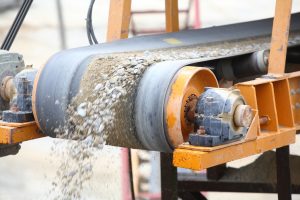3 Ways How to Improve Material Handling
Comments Off on 3 Ways How to Improve Material Handling
Poor material handling slows down production, incurs costs, and even creates safety or sanitation hazards that can lead to expensive fines and plant shutdowns. Here are some ways to improve material handling for better efficiency and lower costs.
Evaluate your process
Identify the areas where there is poor material flow. Then, diagnose the causes and the impact of the problem on your productivity and costs. From there, you will have a more concrete idea of how to improve material handling.
For example, a cement company in Asia needed to achieve a flow rate of 30 tons per hour, but could not hit their productivity targets because of shale clogging in the silos. Workers had to manually clear the vessels, which meant stopping the process and pulling teams assigned to other parts of the plant. They calculated that they lost $12,000 for every hour of downtime.
Once the cement company installed AirSweep in the silos, productivity surged and costs went down.
Know your material’s flow properties
Materials have different flow rates and properties that can pose challenges whenever they are stored, transported, and processed. Even changing one material in the formula can lead to unexpected issues during production.
For example, a major international paint and coatings manufacturer needed to use a new grade of Titanium Dioxide (TiO2) to improve their product. The material had finer, lighter particles and had a tendency to bridge over the vibrating feeder system.
They installed AirSweep and designed it to automatically activate when a flow sensor detected bridging in the bottom feeder. This enabled them to cut the batch processing time to just 15 minutes.
Identify risks
One of the best ways to improve material handling is to prevent issues from even occurring. Look at your process and identify possible risks or hazards.
For example, a concrete company uses 12 mixers, with feeders loading up to 250 tons of gravel an hour, or 4 tons a minute. With that amount of gravel, any equipment failure and resulting material pileup would cause safety issues and days of shoveling.
The company installed a DAZIC zero speed switch that would trigger an alarm if any equipment showed an abnormal change in speed. It was a simple, affordable fix that prevented incidents from happening.
Find out how to improve material handling
Control Concepts, Inc. has helped thousands of plants around the world improve bulk material handling. We have worked with every industry, with clients that include both S&P companies and SMEs. Contact us to get a customized proposal for your process.
What Materials Are Prone to Problems in Material Handling?
Comments Off on What Materials Are Prone to Problems in Material Handling?
One of the most common problems in material handling is how to get material to flow properly. Many materials have a tendency to clump, cake, or interlock during storage or mixing. That can impact the entire production process, and lead to unnecessary costs and safety issues.
Types of material blocks
Some materials have cohesive properties that cause particles to stick together. This can lead to bridging or ratholing.
During bridging, the material forms an arch above the outlet of the silo or hopper. The particles interlock and bond together because of cohesive strength and internal friction, while the wall friction holds up the ends of the arch.
During ratholing, the material adheres to the container sides, so the flow is limited to just above the container outlet. As more material flows through and accumulates on the walls, the block becomes bigger and more compact.
Bridging and ratholing can lead to all sorts of problems with bulk material handling. It slows down production, causes material waste, and compromises the formula’s consistency and quality. And if workers have to clear the blocks manually—by hammering or even climbing down into silos or hoppers with pick axes—they’re at risk for injury and unnecessary exposure to the material.
Problematic powders
About 50% of manufactured materials use powders at some stage of production. However, many powders are cohesive, which means they have a tendency to cake or become compact under their own mass.
Food ingredients
Some powders like flour have “easy” flow properties; any chunks can be broken apart with gentle aeration. However, heavier powders like cocoa, lecithin, whey, milk, sugar and sweeteners, spices, or even binders and preservatives will form solid, rock-hard chunks.
The food industry also needs to achieve first in/first out flow to avoid stagnant material that can spoil, thus compromising the product’s safety and breaking strict regulations on sanitation and hygiene.
Spoiled material and off-spec batches need to be thrown away, and even a single “bad batch” that escapes quality control can lead to product recalls.
Pharmaceutical powders
An estimated 60% of pharmaceutical sales come from powder formulations such as tablets, capsules, sachets, or inhalable powders.
During processing, pharmaceutical powders will go through several phases where they are exposed to moisture and air. These environmental factors—and variables in properties like size, shape, and texture—affect the flow properties, density, compressibility, and permeability.
These can pose numerous problems in material handling that must be managed well to ensure product efficacy and safety. Pharmaceuticals rely on precise measurements and proportions of ingredients. Material blocks can ruin an entire batch, and lead to material waste or even product recalls.
Grain products
One of the most common problems in material handling arises when conveying grain products from storage silos or bins. The materials may have sat motionless for days or even weeks, and have settled and become more compact. So, their flow properties are very different from powders or granules in aerated samples.
Some examples of common grain products are cornstarch, wheat bran, polenta, tapioca, couscous, rice, and hops. These are used in the food, pet food, beverage, nutraceutical, cosmetic and biofuel industries.
Cement powders
Cement uses many types of powders, including limestone, chalk, glass powder, and steel slag powder (SSP). Sometimes, granite powder is used in place of sand.
These materials all have unique flow properties, and the challenges increase when they are mixed and become sticky, moist, and heavy. Many cement plants have issues with materials bridging over silos and hoppers, which can slow down production speed and vessel capacity by as much as 80%.
Chemical powders
Many industries use chemicals either as a main material, or as a binder, preservative, or enhancer. For example, rubber tire manufacturers use carbon black to improve durability and performance. Battery manufacturers use lithium chloride and carbonate.
These chemicals can cause problems in material handling if they have a high moisture content, or have high cohesive properties. Some materials like carbon black tend to fluidize, forming deposits along the conveyor lines and storage vessels. Since it does not dissolve in water and solvents, cleaning can be time-consuming and expensive.
AirSweep solves problems in material handling
Leading companies in different industries rely on AirSweep to prevent bridging, ratholing, and other problems in material handling. Each nozzle emits a high-pressure, high-volume, 360-degree burst of compressed air to lift and sweep stalled material back into the flow stream – clearing the way for higher factory and material handling efficiency.
- Watch material flow videos to see how AirSweep can activate even the toughest materials, from heavy powders to sticky and moist solids
- Read case studies on how companies have increased productivity and reduced costs after installing an AirSweep system
- Compare AirSweep with other flow aids and find out why it works better than vibrators, fluidizers, and air cannons
You can also contact us to get a personalized consultation on how AirSweep can solve the specific problems in material handling that you encounter in your plant.
Top Challenges for Material Handling in the Candy Industry
Comments Off on Top Challenges for Material Handling in the Candy Industry
Life isn’t always sweet for the candy and confectionary industry. The industry works with many materials that are prone to bridging, ratholing, and material blocks. Without a good flow aid, production can stall and end up in a big, sticky mess. We will review the top challenges for material handling in the candy industry.
Most common challenges in material handling
Candy and confectionary can use many different materials, ranging from powders to oily or moist solids, small particles to large pieces of nuts, or brittle.
These materials have unique characteristics that can affect material flow and production.
- Free flowing and non-free flowing powders. While some flow freely from the force of gravity, others have more cohesive properties and are prone to packing during storage, and bridging and ratholing during production.
- Moist, oily, or sticky liquids and solids. These include raw materials like honey and end-products like caramel. Some materials have a tendency to cake and smear on vessel walls; others can crystallize or thicken under certain plant conditions, further inhibiting material flow.
- Blends and mixes. These can have ingredients that are different sizes, shapes, and densities. Aside from sticking to the sides of the vessel, the mix can segregate and compromise batch uniformity.
- Hygroscopic materials. These have a tendency to attract and retain moisture, which leads to clumping and caking during storage and mixing.
- Corrosive materials. The food industry uses concentrated acids, chlorides, and chemicals like sodium bisulfite and sodium sulfite. Aside from this, the food industry uses hot steam and chemical solutions to clean vessels and meet sanitation standards. This highly caustic environment means that the vessels—and any attached material flow aids—have to be made of materials that resist corrosion.
- Abrasive materials. Grains and hard crystals like polyols can wear down vessel walls.
- Perishable materials. Almost all materials used in making confectionaries are easily spoiled and contaminated and need both careful handling and first-in/first-out material flow.
Best flow aid for the candy industry
AirSweep is the best flow aid for tough materials. The powerful air pulses can handle cohesive powders and even moist, oily, and sticky mixes. It is used by food manufacturers around the world, many of whom switched to AirSweep because it performed better than vibrators, fluidizers, and other flow aids.
R. M. Palmer, a candy manufacturer in Pennsylvania, produces specialty holiday confections for US and international distribution. It uses a fine cocoa powder with 12% oil content, which caused bridging and ratholing in the hoppers and required manual cleaning every three to four days.
After installing AirSweep, the plant went from downtime every 3 or 4 days to “no breakdowns, replacements, or any problems whatsoever.” They were even able to add two production shifts per month, increasing productivity and profit margins so much that they were able to recover the cost of the system in just two months.
“AirSweep works,” he said. “It has a stronger air pulse than the bin aerators or fluidizers we previously installed. The air moves the powder down in a very large column so powder doesn’t stick to the walls.”
5 benefits of AirSweep for the candy industry
AirSweep’s unique construction also makes it ideal for the unique conditions of the candy and confectionary industry.
- Guaranteed on-demand, first-in / first-out flow prevents material stagnation and spoilage
- USDA-accepted design meets the strictest standards for sanitary equipment
- Air-tight nozzle snaps shut after each pulse, preventing fine powders and dust from entering the system
- Durable finish resists abrasion and corrosion and can be safely cleaned with chemical agents
- Fast and easy assembly allows the unit to be removed for cleaning without any special tools
Get a customized proposal for your process
AirSweep is used in thousands of plants around the world and has solved many challenges in material handling that other flow aids could not. Contact us to find out how you can improve your material flow.




